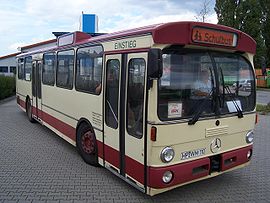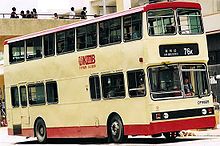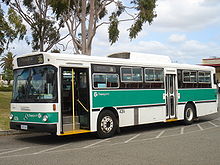- Mercedes-Benz O305
-
Mercedes-Benz O305
VöV fronted O305 in Heppenheim, Germany.Manufacturer Mercedes-Benz Specifications Length 11 m Width 2.5 m Floor type Step entrance Doors 2 Engine(s) Diesel Options Various customer options Mercedes-Benz O305 is a rear-engined bus model built in West Germany between 1967 and 1987. The O305 was built as a successor of the O317 and was the Mercedes-Benz adaptation of the first so called "Standard-Linienbus" design, that was produced by many different German bus manufacturers. The articulated model was named O305G, the suburban model O307. Its successor was the Mercedes-Benz O405 respective the O407.
The O305 was basically built for single deckers. Double-deck examples, however, could be found in Hong Kong, Singapore and South Africa.
Contents
Hong Kong
In Hong Kong, it is the first franchised bus model made outside United Kingdom and countries of Commonwealth of Nations. A total of 41 buses were introduced, with the prototype in 1983 and the others in 1985. All were withdrawn and subsequently scrapped in 2001/2002 except three, which are preserved by groups of bus enthusiasts in Hong Kong.
Background and history
For a long period of time, Hong Kong franchised bus operators were required by law to purchase buses produced in Commonwealth countries. After repealing the requirement in 1983, Mercedes-Benz supplied a two-axle 11-metre double-decker to Kowloon Motor Bus (KMB).
The O305 demonstrator was then registered as CZ6686 on 4 August 1983 and was allocated fleet number ME1. Following the successful trials of ME1, KMB ordered 40 buses (ME2-41) of the same kind in 1985, with improved frontal design and ventilation system. All the 41 buses were fitted with Alexander RH-type bodies.
KMB later adopted a policy of acquiring 3-axle double-deckers of similar length. Because Mercedes-Benz did not provide a 3-axle version of O305, no more Mercedes-Benz bus was purchased by KMB.
The services
Initially, the first bus ran on route 105, which was new, running between Lai Chi Kok and Sheung Wan. However, Cross Harbour Tunnel's environment was unsuitable for this model, as well as the fact that the towing of these buses by the tow trucks used by the tunnel authority could result in damage to the chassis, so entire fleet were reallocated to express routes running between Yuen Long and Tsuen Wan/Kowloon. The buses were once renowned for its speed and power, with a maximum speed of over 120 km/h reported.
The buses provided services on the trunk routes in Yuen Long until the mid-1990s. With newer buses (especially those with air conditioning) available for trunk services, the Mercedes were redistributed to North District and Tai Po and served there until their retirement on 22 November 2002. Occasionally, the Mercedes still participate in some inter-district routes into Kowloon or Yuen Long, one of which becoming the last served by Mercedes.
These buses had a unique livery designed by Kowloon Motor Bus, but all of them had the livery returned to the standard livery of KMB non-air-conditioned buses shortly before their re-distribution.
It was reported that bus enthusiasts rushed to take rides and photos of the last Mercedes when they were announced to be retired, possibly due to their unique roles played in Hong Kong bus service history.
Singapore
After the evaluation of two Mercedes-Benz O305 double-deckers acquired c. 1982, Singapore Bus Services acquired 200 Mercedes-Benz O305 double-deckers which were very similar to KMB's O305. It features an 11,412 cc OM 407h engine with its modular W3D 080 R gearbox. With a licensed capacity of 109 passengers, the first of them entered service in 1984 and all of them retired in early 2000s.
Australia
Sydney
Sydney Buses acquired over 1300 O305s of different body styles (by the same body manufacturer - Pressed Metal Corporation, or PMC) between 1977 and 1987. 30 of these were the articulated O305G model.
Originally, the State Transit Authority ordered 200 Mercedes-Benz O305s with PMC Galvastress (MkI) bodywork between 1977 and 1978. One of these was fitted with the Galvastress MkII body. This prototype was the forerunner for the MkII order of 550 Mercedes-Benz O305s. This was the largest bus order in Australia (and still the record hasn't been broken). The MkII body was internally different from the MkI body although the exterior remained very much the same with the edition of a more O305 style roof line, and larger rear windows. The MkII order was started in 1978 and completed in 1981. The reason for this large order was because of the takeover of AEC (most of the older fleet being AEC) left spare parts short, etc.
In mid-1981, the STA called for 100 single-deck vehicles and 30 articulated vehicles with the option of 80 more single-deck vehicles and the winner of this tender was Mercedes-Benz. The STA then took delivery of the 100+80 Mercedes-Benz O305s and 30 articulated O305Gs. The body builder was PMC with its Galvastress MkIII body. The revisions to the body were minor, and the most noticeable was the dropping of the window line (Windows remained the same height and width, just dropped a few centimetres) to line up better with the rear windows and to free more space for the front and rear destination equipment. One of these was fitted with the prototype Galvastress MkIV body. The 30 MB O305Gs were delivered 1983-1984 (the prototype was delivered in 1981). The prototype originally had 3 doors, one at the front, one at the center and one at the rear and wasn't turbocharged (the other 29 were) until the prototype was brought up to standard with the other 29 by removing the rear door and turbocharging the engine (177 kW to 209 kW). Two out of the batch had received ZF 5HP500 gearboxes and still have them.
The MkIV prototype went on to start the next order of O305s, 353 of them were delivered between 1984 and 1987. The chassis was slightly revised, and it was the first bus chassis the STA had operated with ABS. The Galvastress body was revised again with the addition of a square roof and fitted with square rear indicators, although the interior differed little from the MkIII. However, the bus was longer, with a length of 10.75 meters instead of 10.67 meters.
Although all of the MKIs, MKIIs, O305Gs and MKIIIs have been withdrawn, there are still over 200 O305's serving Sydney Buses.
Transmission and engine specifications
- Engine
- Type: OM 407 h
- Position: Rear Underfloor
- Capacity: 11.413 litres
- No. of cylinders: 6, inline
- Compression Ratio: 16.5:1
- Bore: 125 mm
- Stroke: 155 mm
- Max power: 147 kW @ 2200 rpm
- Max torque: 715 Nm @ 1400 rpm
- Max gov. speed: 2200 rpm
- Fuel Pump: Bosch
- Injectors: Bosch
- Transmission
- Type: W3D O80/2.2R
- Torque converter: 5.95:1, max speed 13 km/h
- 1st ratio: 2.12:1, road speed: 35 km/h
- 2nd ratio: 1.35:1, road speed: 55 km/h
- 3rd ratio: 1:1, road speed: 75 km/h
- Reverse ratio: 2.23:1
- Rear axle type: H07/8DL/10
- Final drive ratio: 5.9:1
Perth
Perth was the first Australian city to operate the Mercedes-Benz O305. The first units entered service with the Metropolitan Transport Trust (MTT) in 1975. Over a period of eleven years between 1975 and 1986, over 400 MB O305's were purchased for the city. Transperth (the new name for the MTT starting in 1986) and its contractors began withdrawing this sizeable fleet of O305's in October 1999 following the start of delivery of some 350 Mercedes-Benz O405NH low floor buses. The gradual withdrawal of these buses over the past nine years has made the O305 a very rare sight in the metropolitan corridor; the buses are seen a little more often in the eastern hills area. Transperth operates 4 MB O305's in regular service as of August 2010.
Compared to the Sydney units, the Perth units feature different bodywork (manufactured by Freighter Industries, J. W. Bolton, Hillquip, or Howard Porter) and a higher final drive ratio (5.2:1). There have been some unusual O305's operating in Perth. Examples include No. 444, which features a Mauri (Italy) body assembled locally by J. W. Bolton (since removed from service as part of the fleet renewal program), and No. 007, an experimental bus (model OG305) with an LPG-fuelled engine (also since removed). In 1984, the MTT operated Australia's first CNG-fuelled bus - O305 No. 008. From the success of the trial gas buses, two O305s were converted to LPG operation in the early 1980s, a CNG-fuelled OG305 was ordered and entered service in 1987 (No. 009) and 26 O305s were converted to CNG in the early 1990s.
As the fleet upgrades, more and more CNG buses are retired from service, and few private operators have the capacity to install a CNG refill system. These buses face an uncertain future, but seem likely to follow buses No. 008 and No. 533 which were purchased to be immediately wrecked to provide replacement parts for existing diesels in the new owners fleet.
Perth was also the first Australian city to operate the articulated Mercedes-Benz O305G. Three batches were purchased including 18 in 1979, 3 in 1980, and 19 in 1986-1987. The first and second batches had bodywork completed by J. W. Bolton and Howard Porter and featured model OM 407h 240 hp (177 kW) naturally aspirated engines. To overcome sluggishness, the buses in the third batch (also featuring Howard Porter bodies but built to the VöV-II design) were fitted with model OM 407hA 280 hp (206 kW) turbocharged engines.
Canberra
 Ansair-bodied Mercedes-Benz O305 buses which were owned by ACTION in Fearnes Coaches livery but have since been withdrawn and sold.
Ansair-bodied Mercedes-Benz O305 buses which were owned by ACTION in Fearnes Coaches livery but have since been withdrawn and sold.
Canberra also invested in a batch of Mercedes-Benz O305 citybuses with locally built Ansair (Melbourne) bodies. They were built with standard Mercedes-Benz "StULB" fronts. A total of 85 of these units were delivered in 1984[1] and then tendered for disposal firstly in 1995 and then at several other intervals until 1999. Most units now operate with private bus companies in the Sydney metropolitan area as well as others scattered around the country. 12 were also exported to New Zealand to operate in Auckland and Wellington.
In addition to a large batch of MAN SG192 articulated vehicles purchased in the 1970s, 5 Mercedes-Benz O305G articulated vehicles were delivered in 1984. These vehicles were identical to the 85 MB O305s and the additional of a concertina and tralier unit. Once again, these units were tendered for disposal in 1997/1998 and disposed of to various private bus companies around Australia.
Adelaide
The first buses to enter service on the O-Bahn were specially modified Mercedes-Benz O305 models. A fleet of 41 rigid and 51 articulated buses was purchased, their cost included in the original $98 million budget. The chassis were bought from Germany and heavily modified at the Mitsubishi Motors plant in Tonsley. The rigid buses had their power increased to 240 hp (177 kW) and the articulateds to 280 hp (207 kW); they were the first buses to travel at a speed of 100 km/h on suburban routes.
New Zealand
Auckland
Auckland Regional Authority and its successors had a fleet of over 300 Mercedes-Benz O305 buses (Fleet numbers 1301-1600) which were in use until 2005. Many of these had been sold to other bus operators or converted for other uses including house buses. All were fitted with locally produced VoV bodies.
Israel
Egged in Israel purchased 1111 O305s, 756 of them had Israeli made bodies.
References
Categories:- Buses
- Mercedes-Benz vehicles
Wikimedia Foundation. 2010.



